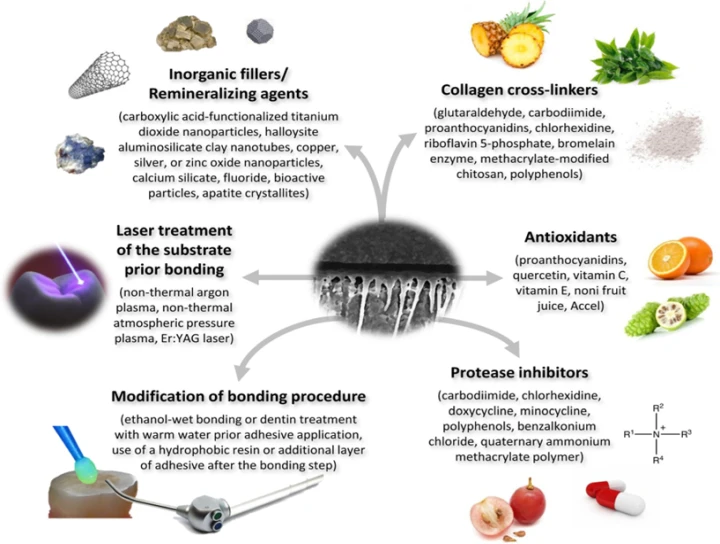
introduction
Success in adhesive dentistry means long-lasting restorations. Notwithstanding, the loss of adhesion or retention of a resin composite restoration is a frequent problem observed by dental practitioners, especially due to bond strength degradation.
There are currently six major strategies available to overcome resin-dentin bond degradation:

Modification of the Bonding Protocol
A few recent studies have also suggested that by modifying the bonding protocol of adhesive systems, significant gains in the immediate and/or long-term resin-dentin bonds.
|
METHOD |
PROCEDURE |
REASON |
|
Modification of the Bonding Protocol | Prior to bonding steps, dentin was dehydrated by application of 50% ethanol for 10 s, followed by 100% absolute ethanol for 10 s, excess ethanol was then blot-dried | The ethanol-wet bonding technique allowed for better resin infiltration due to early evaporation of water molecules from the interfibrillar spaces of collagen fibrils. Moreover, adhesive polymerization may be facilitated, thus improving the resin-dentin bonds |
| Prior to the bonding steps, the dentin was rinsed with distilled water at warm (50 ± 2°C), cold (5 ± 2°C),or room temperature (22 ± 2°C) for 20 s, and then blotted dry with a cotton pellet to reduce temperature fluctuations | At least for the etch-and-rinse approach, rinsing dentin with warm water prior to the bonding procedure may increase free energy of the surface, thus increasing wettability of the adhesive and resin infiltration. The polymerization reaction of monomers may also be improved, and any residual water eliminated from the hybrid layer, thus increasing the resin-dentin bond | |
| Intraradicular dentin was treated with 100% ethanol prior to bonding procedures | Ethanol-wet bonding may reduce the amount of residual water into the root canal, as well as at the hybrid layer level, thus improving resin-dentin bonds | |
| After bonding steps, a hydrophobic resin was applied in the substrate, followed by an air blower to achieve an optimally thin layer of adhesive | The application of a hydrophobic resin coat may improve the degree of conversion in resin-dentin interfaces formed with either the self-etch or etch-and-rinse strategy | |
| The bonding step was performed by applying two consecutive layers of the one-step self-etch adhesive | Application of double coats of the adhesive resin produced longer resin tags than a single coat on both sound and demineralized dentin. Also, hydrolysis was probably lesser in the former situation, resulting in improved resin-dentin bonds |
CONCLUSION
Although immediate resin-dentin bonds are satisfactory, degradation of the adhesive interface is a common problem that reduces the longevity of restorations. However, based on the current literature, recent improvements in the formulation of dental adhesives have contributed to the development of ‘smart’ adhesives that may prevent bond strength degradation.


No Any Replies to “Strategies in Enhancing Resin Bonding to Dental Substrates”
Leave a Reply